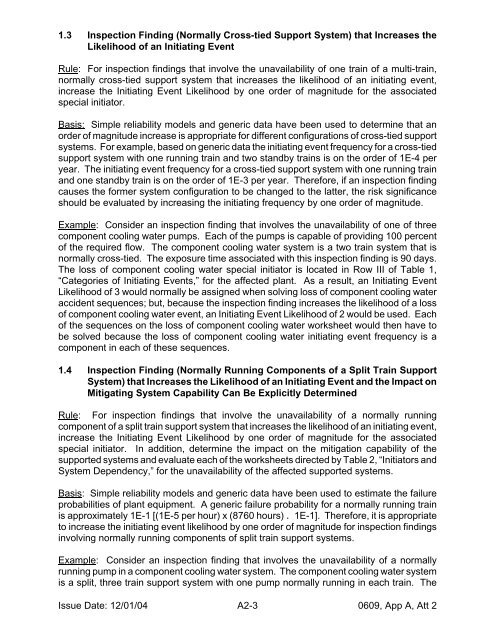IMC 0609, App A - NRC
IMC 0609, App A - NRC
IMC 0609, App A - NRC
Create successful ePaper yourself
Turn your PDF publications into a flip-book with our unique Google optimized e-Paper software.
1.3 Inspection Finding (Normally Cross-tied Support System) that Increases the<br />
Likelihood of an Initiating Event<br />
Rule: For inspection findings that involve the unavailability of one train of a multi-train,<br />
normally cross-tied support system that increases the likelihood of an initiating event,<br />
increase the Initiating Event Likelihood by one order of magnitude for the associated<br />
special initiator.<br />
Basis: Simple reliability models and generic data have been used to determine that an<br />
order of magnitude increase is appropriate for different configurations of cross-tied support<br />
systems. For example, based on generic data the initiating event frequency for a cross-tied<br />
support system with one running train and two standby trains is on the order of 1E-4 per<br />
year. The initiating event frequency for a cross-tied support system with one running train<br />
and one standby train is on the order of 1E-3 per year. Therefore, if an inspection finding<br />
causes the former system configuration to be changed to the latter, the risk significance<br />
should be evaluated by increasing the initiating frequency by one order of magnitude.<br />
Example: Consider an inspection finding that involves the unavailability of one of three<br />
component cooling water pumps. Each of the pumps is capable of providing 100 percent<br />
of the required flow. The component cooling water system is a two train system that is<br />
normally cross-tied. The exposure time associated with this inspection finding is 90 days.<br />
The loss of component cooling water special initiator is located in Row III of Table 1,<br />
“Categories of Initiating Events,” for the affected plant. As a result, an Initiating Event<br />
Likelihood of 3 would normally be assigned when solving loss of component cooling water<br />
accident sequences; but, because the inspection finding increases the likelihood of a loss<br />
of component cooling water event, an Initiating Event Likelihood of 2 would be used. Each<br />
of the sequences on the loss of component cooling water worksheet would then have to<br />
be solved because the loss of component cooling water initiating event frequency is a<br />
component in each of these sequences.<br />
1.4 Inspection Finding (Normally Running Components of a Split Train Support<br />
System) that Increases the Likelihood of an Initiating Event and the Impact on<br />
Mitigating System Capability Can Be Explicitly Determined<br />
Rule: For inspection findings that involve the unavailability of a normally running<br />
component of a split train support system that increases the likelihood of an initiating event,<br />
increase the Initiating Event Likelihood by one order of magnitude for the associated<br />
special initiator. In addition, determine the impact on the mitigation capability of the<br />
supported systems and evaluate each of the worksheets directed by Table 2, “Initiators and<br />
System Dependency,” for the unavailability of the affected supported systems.<br />
Basis: Simple reliability models and generic data have been used to estimate the failure<br />
probabilities of plant equipment. A generic failure probability for a normally running train<br />
is approximately 1E-1 [(1E-5 per hour) x (8760 hours) . 1E-1]. Therefore, it is appropriate<br />
to increase the initiating event likelihood by one order of magnitude for inspection findings<br />
involving normally running components of split train support systems.<br />
Example: Consider an inspection finding that involves the unavailability of a normally<br />
running pump in a component cooling water system. The component cooling water system<br />
is a split, three train support system with one pump normally running in each train. The<br />
Issue Date: 12/01/04 A2-3 <strong>0609</strong>, <strong>App</strong> A, Att 2
















